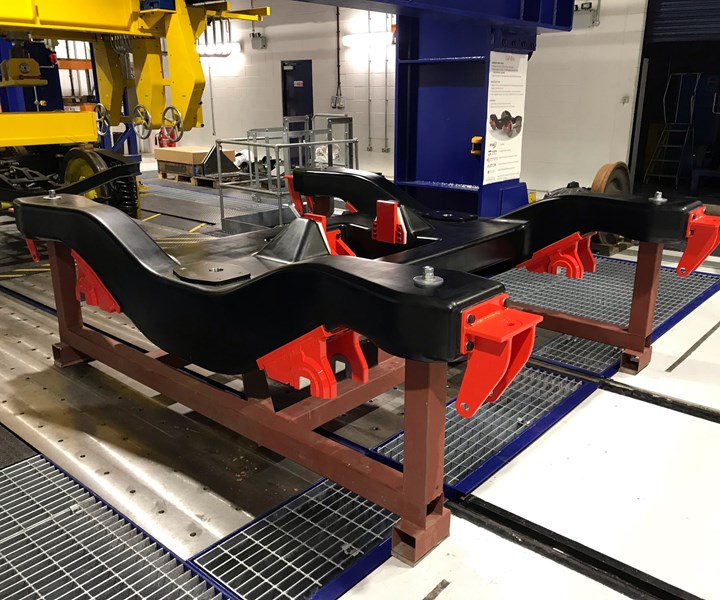Carbon fiber composite rail bogie unveiled
The CAFIBO rail bogie is constructed from recycled and surplus carbon fiber and was developed by ELG Carbon Fibre and partners.

Source | ELG Carbon Fibre Ltd.
On Dec. 10, the world’s first carbon fiber rail bogie (called CAFIBO) was officially unveiled by developer ELG Carbon Fibre (Coseley, U.K.) and collaborator the University of Huddersfield’s Institute for Railway Research.
The bogie, which is made entirely out of surplus and recycled carbon fiber materials (see CW’s feature on the bogie’s design), was presented to more than 100 industry delegates at the Railway Industry Association’s (RIA) Unlocking Innovation event at the University of Huddersfield.
The new CAFIBO bogie is reportedly lighter than conventional bogies, and optimizes vertical and transverse stiffness. This bogie will:
- reduce track wear and infrastructure maintenance costs by reducing vertical and transverse loads on the rails,
- improve reliability and operational availability through an embedded health monitoring system, and
- reduce energy consumption and hence global warming footprint.
The bogie is being developed as part of a two-year program delivered by consortium ELG Carbon Fibre, Magma Structures (Portsmouth, U.K.), the University of Birmingham and the University of Huddersfield with additional support from Alstom (London, U.K.). Over the next few months, the bogie will be tested on the University of Huddersfield’s state-of-the-art test rolling rig named the Huddersfield Adhesion & Rolling contact Laboratory Dynamics rig, or ‘HAROLD.’
“Replacing steel with recycled carbon fiber to produce a rail bogie is a world first so it is a hugely exciting and rewarding project to be part of,” says Frazer Barnes, managing director of ELG Carbon Fibre. “We hope to make recycled carbon not only an attractive option for the rail industry in terms of weight reduction but also to eliminate waste and drive down cost.”
“There are significant potential benefits from adopting novel materials and construction methods in railway vehicle bogies,” says Simon Iwnicki, director of the Institute of Railway Research at the University of Huddersfield. “The reduction in mass results in energy savings but can also reduce track forces and improve dynamic performance. I hope that the tests on the CAFIBO bogie being carried out here at Huddersfield will help to encourage the railway industry to accept these new techniques.”
Related Content
-
McLaren celebrates 10 years of the McLaren P1 hybrid hypercar
Lightweight carbon fiber construction, Formula 1-inspired aerodynamics and high-performance hybrid powertrain technologies hallmark this hybrid vehicle, serve as a springboard for new race cars.
-
Sulapac introduces Sulapac Flow 1.7 to replace PLA, ABS and PP in FDM, FGF
Available as filament and granules for extrusion, new wood composite matches properties yet is compostable, eliminates microplastics and reduces carbon footprint.
-
Cryo-compressed hydrogen, the best solution for storage and refueling stations?
Cryomotive’s CRYOGAS solution claims the highest storage density, lowest refueling cost and widest operating range without H2 losses while using one-fifth the carbon fiber required in compressed gas tanks.

.jpg;width=70;height=70;mode=crop)








.jpg;maxWidth=300;quality=90)




